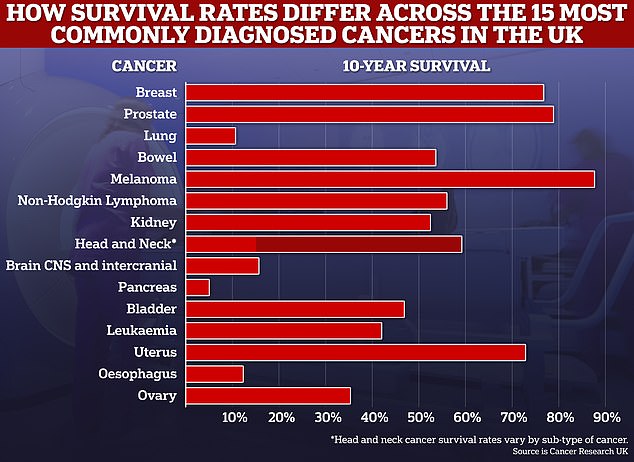Five early warning signs of pancreatic cancer revealed after shock diagnosis of Countryfile star Adam Henson’s wife Charlie
Countryfile’s Adam Henson has revealed how he rushed to marry his wife after being diagnosed with pancreatic cancer.
The TV presenter, 57, said he felt like he had been ‘hit with a sledgehammer’ when Charlie, his partner of 28 years, was told she had the disease in August 2021.
The couple, who dated in sixth grade before officially getting together in their 20s, walked down the aisle the following month because getting married “suddenly was a big deal,” said Charlie, a location manager in the TV industry .
Charlie, one of around 10,500 Britons diagnosed with pancreatic cancer each year, is now in ‘continuing recovery’ and undergoes a scan every six months after surgery to remove the tumor.
Crippling diarrhea and dramatic weight loss were among the symptoms she suffered before the diagnosis. Here, MailOnline shares the warning signs of the ‘silent killer’.

Pancreatic cancer is also called a ‘silent killer’ because of its subtle symptoms that are often not noticed until too late

The Countryfile star, 57, has told how his wedding vows allowed him to ‘cement’ his emotions after Charlie (pictured in November 2019) was diagnosed with pancreatic cancer
Jaundice
Jaundice, the yellowing of the skin and eyes, is one of the most common early symptoms of pancreatic cancer.
It is caused by the buildup of bilirubin, a yellow-brown substance produced by the liver. The liver releases bile, a fluid intended to aid digestion and which contains bilirubin.
With normal liver function, bile flows through channels to the intestine and helps break down fats.
However, when the bile ducts become blocked, bilirubin builds up, causing the skin and eyes to turn yellow.
In pancreatic cancer, this can occur because a tumor from the adjacent pancreas presses on the bile ducts.
Jaundice only occurs in some patients with early pancreatic cancer because the bile ducts only become blocked when the tumor grows on a certain part of the organ.
Other signs of jaundice include dark urine, light-colored or greasy stools, and itchy skin.
The yellowing of the skin that occurs with jaundice can be more difficult to spot for people with black or brown skin.
Stomach ache
Tumors that grow in certain parts of the pancreas can press on other organs and nerves in the body, causing pain in the stomach area.
Patients describe it as a ‘dull’ pain that feels as if it is ‘boring’ and usually appears in the upper part of the abdomen.
This pain can also occur if a tumor blocks the digestive tract.
Pain may come and go at first, but will become more constant as the disease progresses.
It may feel worse when lying down or after eating, but can be relieved by sitting forward.
However, it should be noted that pain is only a possible symptom of pancreatic cancer.
Some patients experience no pain at all due to the precise location of their tumor.

While survival for some types of cancer has improved in recent decades, such as breast and prostate cancer, others, such as lung and pancreatic cancer, have improved at a snail’s pace.

Ten-year survival rates for common cancers have now exceeded 50 percent. However, for pancreatic cancer it remains around five percent
Backache
Pain can also radiate from the stomach to the back.
This pain is generally persistent and is usually localized in the middle of the back or just below the shoulder blades.
If this symptom occurs at all, like stomach pain, it may depend on the specific location of the tumor.
Some patients have only back pain and no stomach pain, again linked to the specific shape of their tumor and how it presses on other tissues.
Sudden weight loss
People with pancreatic cancer may experience unexplained weight loss.
This can be due to problems with the pancreas, which helps digest food, and/or because people lose their appetite due to other symptoms such as pain.
Cancers can also drain energy from the body as tumors grow, which can also lead to weight loss.
People with unexplained weight loss in combination with other complaints such as pain or changes in bowel habits are advised to talk to their doctor about this.
Floating feces
Unusual changes in bowel habits may be a sign of pancreatic cancer.
This can take the form of constipation or diarrhea due to the general disruption of the digestive process.
But a specific sign can be floating, pale and oily poop.
Medically known as steatorrhea. These are frequent, large bowel movements that are pale colored, smelly, float in the toilet bowl and are difficult to flush away.
They are caused by fat that is normally absorbed by the body, but goes undigested and passes into the feces.
This is caused by pancreatic cancer disrupting the normal digestive process and limiting the amounts of pancreatic enzymes released into the intestines.
These enzymes help digest food, and a lack of them leads to problems because undigested food passes quickly through the digestive tract.
